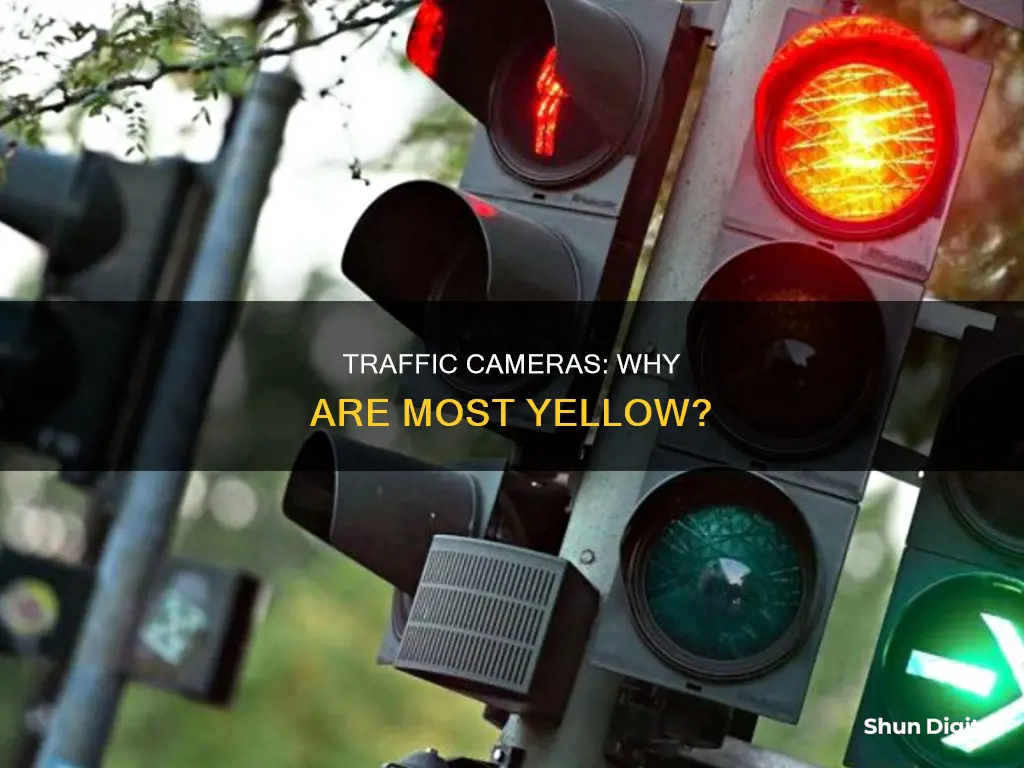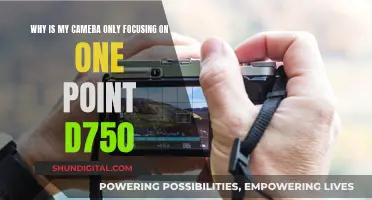
Traffic cameras are used to monitor and enforce road safety, with the majority being rear-facing to capture images of vehicles' license plates. While not all traffic cameras are yellow, guidelines have been issued by governments to improve their visibility and ensure motorists are not unfairly penalised. For instance, in the UK, all speed cameras on the strategic road network should be painted yellow, although this is not a legal requirement. In contrast, cameras monitoring bus lanes, traffic lights, and parking infringements are typically finished in grey.
| Characteristics | Values |
|---|---|
| Colour | Yellow |
| Purpose | To improve speed camera visibility to ensure motorists are not unfairly penalised |
| History | In 2016, the UK government issued guidelines stating that speed cameras should be painted yellow or be mounted in yellow casings |
| Visibility | Some speed cameras can still be difficult to spot, especially mobile units |
| Benefits | The yellow cameras are considered by many to be a significant improvement over the old, grey cameras |
| Camera Types | Average speed cameras, variable speed cameras, traffic light cameras, mobile speed cameras |
What You'll Learn
- Speed cameras are yellow to improve visibility and ensure motorists are not unfairly penalised
- Red light cameras don't constantly snap pictures but are triggered by sensors
- Speed cameras use road markings or radar technology to identify vehicles and record their speed
- Average speed cameras use automatic number plate reading (ANPR) technology to record a vehicle's speed between two points
- Speed cameras are contentious, but they improve road safety and reduce accidents and fatalities

Speed cameras are yellow to improve visibility and ensure motorists are not unfairly penalised
Speed cameras are painted yellow to improve their visibility and ensure that motorists are not unfairly penalised. In 2015, the UK government announced that all working speed cameras on the country's strategic road network would be yellow by October 2016. This decision was made following a review of speed camera policy on motorways, with the aim of increasing the visibility of these cameras.
The change to yellow speed cameras was supported by various organisations, including Highways England and the AA. Highways England acknowledged the valuable role of speed cameras in enhancing safety, smoothing traffic flow, and reducing congestion. They emphasised that cameras are used for safety and traffic management only when other solutions are inadequate. The AA also welcomed the move, noting that their surveys showed over 70% of drivers accepted the use of speed cameras and that increased visibility would help maintain trust and transparency.
The yellow colour is chosen specifically to make the cameras more noticeable to drivers. This is particularly important as mobile speed cameras can be challenging to spot. By making the cameras more visible, drivers are less likely to be caught off-guard and unintentionally break the speed limit. Additionally, the yellow colour helps to reinforce the purpose of speed cameras as a safety measure rather than a tool for revenue raising.
While some may view speed cameras as a burden, they are an important tool for maintaining and improving road safety. Studies have shown that speed cameras can significantly reduce accidents and fatalities. By encouraging drivers to stick to the speed limit, these cameras help create safer road conditions for everyone.
Camera Tickets: Ohio's Law and Your Rights
You may want to see also

Red light cameras don't constantly snap pictures but are triggered by sensors
While red light cameras can be a looming and almost mythical threat to drivers, they don't constantly snap pictures. They are triggered by sensors installed in the road. When a vehicle drives into an intersection and passes the stop line, these sensors trigger the camera to take a picture. This system is connected to the traffic signal and to the sensors buried in the pavement at the crosswalk or stop line.
The criteria that will trigger the camera to photograph a vehicle are determined by traffic engineers. Red light cameras usually only photograph the license tag of the vehicle, but they can also photograph the driver, depending on the state and its laws. Typically, two photographs are taken: one when the vehicle crosses the stop line and a second when the vehicle is in the intersection. The photographs also include the date, time, place, vehicle speed, and elapsed time from the light turning red to the time the photograph was taken.
False alarms can occur when drivers inadvertently get caught in the intersection due to stopping suddenly or turning right on a red light. To avoid this, traffic engineers program the system to photograph only those vehicles that are moving faster than a predetermined speed and that enter the intersection a predetermined time after the signal has turned red. This ensures that drivers who enter on a yellow light or make legal turns on a red light are not photographed.
Red light cameras are not very common due to their high installation cost. They are mostly found in big cities that can afford them and have issues with drivers running red lights.
Cropping Images: Adobe Camera Raw's Percentage Trick
You may want to see also

Speed cameras use road markings or radar technology to identify vehicles and record their speed
Speed cameras are a type of traffic enforcement camera that can be mounted beside or above a road or installed in an enforcement vehicle. They use road markings or radar technology to identify vehicles and record their speed.
Speed cameras work by recording a vehicle's speed. They do this by using markings on the road or radar technology to identify the vehicle and record its speed. Older cameras used film to record speeding offences, but advances in technology have resulted in speed cameras being digitised. If a vehicle is travelling at an excessive speed, two digital images are taken to work out how long it has taken the vehicle to travel between two points on the road. The images also record the vehicle's registration, time of the offence, and speed limit of the road.
Fixed speed cameras are typically mounted on elevated poles at the side of the road and are easy to spot due to their bulky weatherproof enclosures and external flashes. Mobile speed cameras, on the other hand, are more challenging to notice as they are not permanently mounted and can be located on a camera tripod or inside a van. These cameras are often moved around, so it is difficult to rely on crowdsourcing apps or databases to locate them.
Average speed cameras are a type of speed camera that uses automatic number-plate recognition (ANPR) technology to record a vehicle's speed between two points on a road. These cameras calculate the average speed of a vehicle by recording its number plate, along with the date and time, at multiple locations. If the average speed exceeds the legal speed limit, the system retrieves the ANPR data and recorded images of the passing vehicle, creating an evidence record that is sent to the police.
Speed cameras have been shown to be effective in reducing speeding and the number of accidents and injuries on the road. For example, a review by the UK Department for Transport estimated that cameras led to a 22% reduction in personal injury collisions and a 42% reduction in the number of people killed or seriously injured at camera sites. Additionally, an LSE study found that adding 1,000 cameras to British roads could save up to 190 lives annually and reduce up to 1,130 collisions.
How to Know if Your Computer Camera is Hacked
You may want to see also

Average speed cameras use automatic number plate reading (ANPR) technology to record a vehicle's speed between two points
Traffic cameras come in different colours, depending on the manufacturer and the region. However, in the UK, average speed enforcement cameras are painted yellow.
The detection setup requires cameras in at least two locations, often referred to as an "entry camera" and an "exit camera". The vehicle registration plate is recorded using ANPR as it passes the entry and exit cameras, and then the vehicle data is matched. The average speed is calculated from the known distance between the camera locations and the time taken for the vehicle to pass through. If the average speed exceeds the legal speed limit, the system retrieves the ANPR data and recorded images of the passing vehicle, along with date and time stamps from both cameras, creating an evidence record that is sent to the police.
ANPR technology is highly accurate and efficient, capable of reading vehicle number plates without human intervention. It is used by police forces worldwide for law enforcement purposes, including checking if a vehicle is registered or licensed, electronic toll collection, and cataloguing traffic movements. ANPR cameras can also be used to automate access control systems, enhance security, prevent car theft, and improve traffic management.
Unlock Halo Reach Theater's Free Camera Mode
You may want to see also

Speed cameras are contentious, but they improve road safety and reduce accidents and fatalities
Traffic cameras come in many forms, including red light cameras, speed cameras, toll road cameras, and bus lane cameras. While they are often painted yellow, this is not always the case.
Speed cameras, in particular, are a contentious issue. Some people argue that they are simply a way for local governments to make money from fines, rather than a genuine attempt to improve road safety. However, evidence suggests that speed cameras are effective in reducing accidents and fatalities.
For example, a study in the journal Traffic Injury Prevention found that speed cameras reduced crashes resulting in fatalities or serious injuries by 11% to 44%. Similarly, the Department of Transportation found that speed cameras could reduce injury crashes on major city streets by up to 47%.
The presence of speed cameras also discourages speeding. A study in Maryland found that when drivers were aware of the presence of speed cameras, there was a 62% decrease in drivers exceeding the speed limit by more than 10 miles per hour.
In addition to reducing speeding, speed cameras can also help enforce speed limits in areas where traditional police enforcement may be less effective or less feasible. This can include busy urban areas or roadwork zones, where average speed cameras can help ensure drivers adhere to reduced speed limits.
While some may argue against the use of speed cameras, the evidence suggests that they are an effective tool for improving road safety and reducing accidents and fatalities. By enforcing speed limits and discouraging speeding, speed cameras can help create safer roads for everyone.
Computer Vision: Camera Not Detected, Now What?
You may want to see also
Frequently asked questions
No, not all traffic cameras are yellow. In 2016, the UK government issued guidelines stating that speed cameras should be painted yellow or be mounted in yellow casings to improve visibility and ensure motorists are not unfairly penalised. However, local authorities are not obliged to comply, and cameras for monitoring bus lanes, traffic lights, parking infringements, and tolled areas are usually grey.
Traffic cameras are used to monitor and enforce road safety, including speed limits, red-light violations, and other road regulations such as bus lane usage and congestion charging. They can also be used to monitor traffic levels and help reduce congestion.
Traffic cameras use various technologies, including markings on the road, radar, and Automatic Number Plate Recognition (ANPR) to identify vehicles and record their speed, location, and registration details. Some cameras also capture images or videos of vehicles and drivers.







